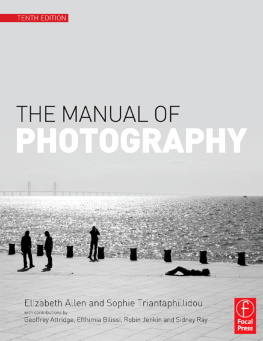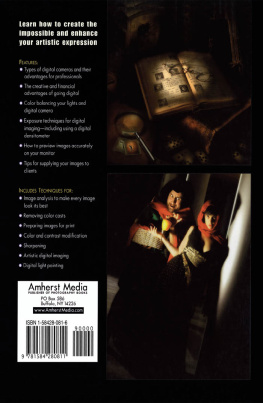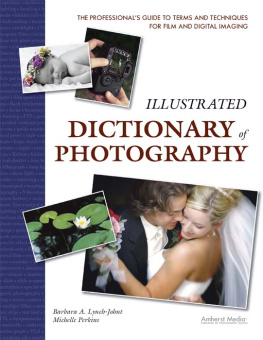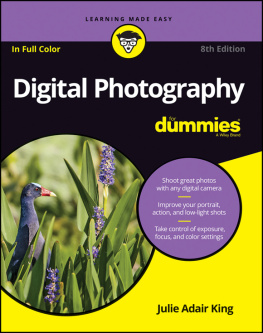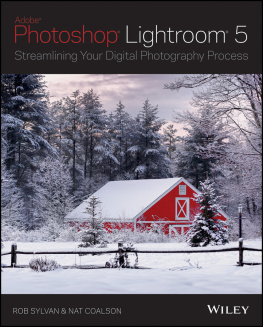Copyright 2011 Elizabeth Allen & Sophie Triantaphillidou. All rights reserved.
Copyright
Focal Press is an imprint of Elsevier
The Boulevard, Langford Lane, Kidlington, Oxford, OX5 1GB, UK
30 Corporate Drive, Suite 400, Burlington, MA 01803, USA
The Ilford Manual of Photography
First published 1890
Fifth edition 1958
Reprinted eight times
The Manual of Photography
Sixth edition 1970
Reprinted 1971, 1972, 1973, 1975
Seventh edition 1978
Reprinted 1978, 1981, 1983, 1987
Eighth edition 1988
Reprinted 1990, 1991, 1993, 1995 (twice), 1997, 1998
Ninth edition, 2000
Tenth edition, 2011
Copyright 2011 Elizabeth Allen & Sophie Triantaphillidou. Published by Elsevier Ltd. All rights reserved.
The rights of Elizabeth Allen & Sophie Triantaphillidou to be identified as the authors of this work has been asserted in accordance with the Copyright, Designs and Patents Act 1988
No part of this publication may be reproduced or transmitted in any form or by any means, electronic or mechanical, including photocopying, recording, or any information storage and retrieval system, without permission in writing from the publisher. Details on how to seek permission, further information about the Publishers permissions policies and our arrangement with organizations such as the Copyright Clearance Center and the Copyright Licensing Agency, can be found at our website: www.elsevier.com/permissions
This book and the individual contributions contained in it are protected under copyright by the Publisher (other than as may be noted herein).
NoticesKnowledge and best practice in this field are constantly changing. As new research and experience broaden our understanding, changes in research methods, professional practices, or medical treatment may become necessary.
Practitioners and researchers must always rely on their own experience and knowledge in evaluating and using any information, methods, compounds, or experiments described herein. In using such information or methods they should be mindful of their own safety and the safety of others, including parties for whom they have a professional responsibility.
To the fullest extent of the law, neither the Publisher nor the authors, contributors, or editors, assume any liability for any injury and/or damage to persons or property as a matter of products liability, negligence or otherwise, or from any use or operation of any methods, products, instructions, or ideas contained in the material herein.
British Library Cataloguing in Publication Data
A catalogue record for this book is available from the British Library
Library of Congress Control Number: 2010933573
ISBN: 978-0-240-52037-7
For information on all Focal Press publications
visit our website at focalpress.com
Printed and bound in China
10 11 12 11 10 9 8 7 6 5 4 3 2 1
Preface to the tenth edition
Although there are many textbooks, monographs and manuals that are available today dedicated to what has now become imaging,
The Manual of Photography stands out as a significant and unique publication. It was first published in the very early days of photography in 1890 under the editorship of C.H. Bothamley at the request of the then Ilford Company as
The Ilford Manual of Photography. The preface to this first edition has set the scene for all later editions:
an endeavour has been made to state, in a simple way, sufficient of the principles to enable the reader to work intelligently, and to overcome most of the difficulties that he is likely to meet with
This firm foundation has persisted throughout all subsequent editions under the guidance of a number of editors leading to this tenth edition.
It has been revised and reprinted many times under only five editors during its 120-year period of publication. Forty years after its initial publication, George E. Brown provided a complete revision and started the tradition of using a number of specialist authors. This reflected the changes in photography that no longer could be fully understood and explained by a single author. The second edition appeared in 1942 under the editorship of James Mitchell, and the third and fourth editions rapidly followed in 1944 and 1949 respectively.
Alan Horder edited the fifth and sixth editions. The sixth edition of 1971 saw the move away from publication by Ilford Limited when it was acquired by the present publishers and the name Ilford was removed from the title. This edition also saw contributions for the first time by two of the contributors to this edition: Sidney Ray on the camera and Geoffrey Attridge on colour photography. In 1978 Ralph Jacobson became the editor for the seventh edition, followed by the eighth edition in 1988 and the ninth edition in 2000. He continued with the specialist contributions from these two authors and others at the then Polytechnic of Central London (now the University of Westminster). The ninth edition of 2000 and certainly this tenth edition must make it one of very few books to have a presence in three centuries. It has come to be valued by many generations of photographers for the straightforward account it provides of both the theory and practice of photography as the technology has evolved.
Sophie Triantaphillidou and Elizabeth Allen are the joint editors of this edition and under their guidance have ensured that the manual remains true to its traditions. In the 10 years since the last revisions were made to the manual there have been many significant technological developments. This edition remains absolutely up to date with explanations of the principles of modern imaging techniques. Like their predecessors they have enlisted the help of their colleagues with specialist knowledge that ensures that the explanations remain both accurate and authoritative.
The previous edition saw a move away from traditional chemical-based photography to the now widely practised electronically based imaging methods. This was in the era of hybrid imaging. Today this is even more apparent with digital camera sales outstripping conventional analogue cameras by around 100 to 1, excluding camera phones and one-shot single-use (recyclable) cameras. In order to provide a balanced basis of modern photographic practice and keep the size of the book within reasonable limits, the editors have been faced with difficult decisions on what to keep, what to discard and what to add. Fortunately much of the core information applies as much to modern electronic systems as it does to analogue chemical systems. Optics and the basic physics of imaging are examples of core areas which also appeared in previous editions. These core areas have been considerably expanded to provide a sound basis for the understanding and practice of digital imaging. Surprisingly, explanations of colour photography were only introduced in 1971, but since then have become a significant topic in subsequent editions. This edition has four chapters devoted to this topic and aspects of colour are of course embedded in other chapters where appropriate.

